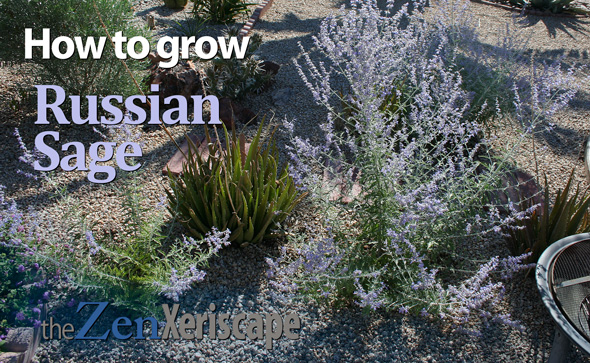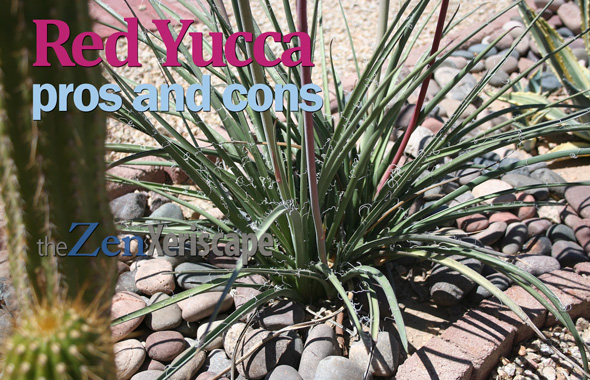I was surprised to learn that bougainvillea plants are drought-tolerant, and that they can thrive in the sunny, hot, and dry conditions common in the southwestern United States. However, this plant does haves its disadvantages, too. Here are the bougainvillea pros and cons for a drought-tolerant landscape.
In the past, I dismissed using bougainvilleas as a viable option for my xeriscape. Mistakenly, I assumed they required a lot of water. But, I was wrong about that—they are drought-tolerant. So, this fall, I planted a few bougainvilleas in my landscape. And I’m really happy with the results, at least so far!
But, just like all plants, there must be some downsides to using bougainvilleas in a landscape. Let’s see what they are!
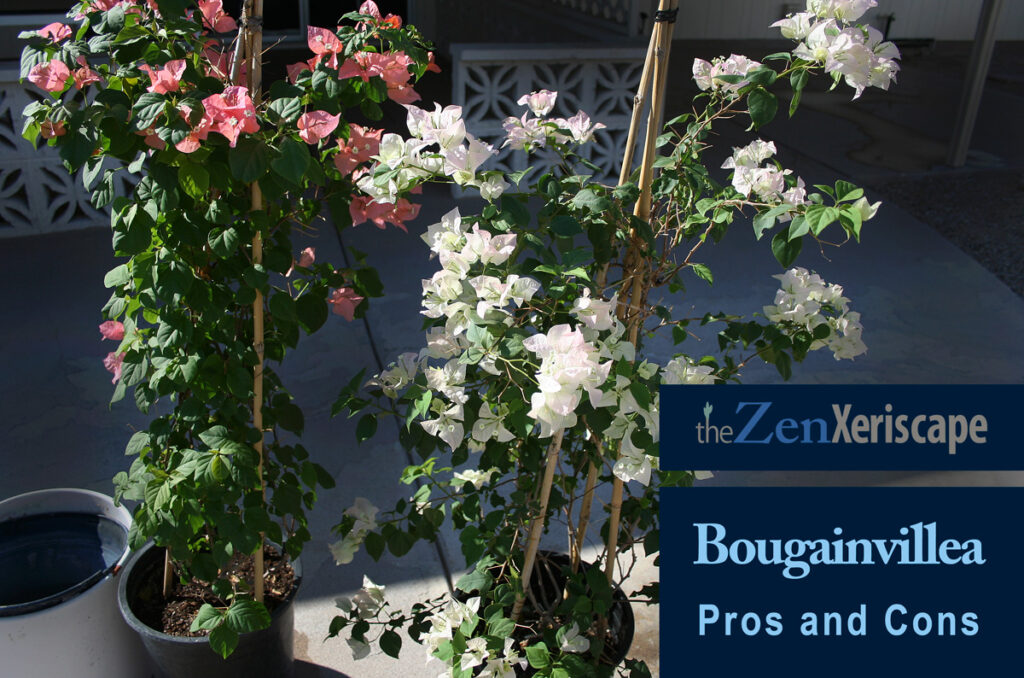
and able to withstand hot summer sun.
Read all the bougainvillea pros and cons!
Photo by Doug Martin
Browse the large variety of live rose plants available on Amazon. Buy only from a reputable dealer. (As an Amazon Associate, I earn a commission from qualifying purchases.)
Bougainvillea pros and cons
PROS:
Tolerant of excess heat:
One of my biggest surprises about bougainvilleas is their tolerance of the excess heat we experience in our southwestern summers. So far, the few that I’ve planted near the end of the summer are really enjoying the hot temps, especially when it gets over 100 degrees F.
Their heat-tolerance capabilities are astounding to me! However, since these plants do originate from the hot, tropical regions of South America, their love of heat really isn’t surprising.
Tolerant of hot sunlight:
For this plant, the more sun the better! Bougainvilleas generally require at least six hours or more of full sun. More sunlight means more flowers and more colorful bracts, as well as more lush vegetation.
Ironically, the bougainvilleas I’ve planted have been more tolerant of the heat and southwestern sun than some of the native plants in my landscape. Right now, I have a few agaves and ponytail palms with yellow vegetation due to heat stress. Meanwhile, the bougainvilleas are thriving. Amazing!
Drought-tolerant:
Bougainvilleas require minimal watering once established. In fact, this plant produces more flowers when it is a little stressed from a lack of water.
However, for my newly planted bougainvilleas, I have been watering deeply when the top few inches of surrounding soil becomes dry. I’ll continue that strategy until the plants develop a healthy root system. Then once established, I’ll do once-weekly waterings during the summer, or even less frequently.
I’ve talked to other growers who have said they water their established bougainvillea plants only once-a-month. Now, that is a truly drought-tolerant plant, making it a great addition to any xeriscape.
Abundant, vibrant color:
Once established, bougainvillea plants will provide a long-lasting display of vibrant color! Unlike typical flowering plants, the bougainvillea produces small, barely noticeable white flowers that are surrounded by colorful leaves, or bracts. The bracts are modified leaves that produce a wide range of vibrant, tropical colors.
The most popular color in my neighborhood is a bright, deep red. I see them blooming almost all year, except maybe in the coolest winter months.
In my case, I decided to try different colors for my bougainvilleas. I plant a beautiful Imperial Thai Delight, which produces flowers that start with a white hue, then turn a pinkish, purplish hue as they age. That is a really beautiful variety.
In addition, I planted a couple of varieties with different orange bracts (Sundown Orange and another orange variety), as well as a California Gold variety. California Gold has a strikingly rich, golden-yellow flower.
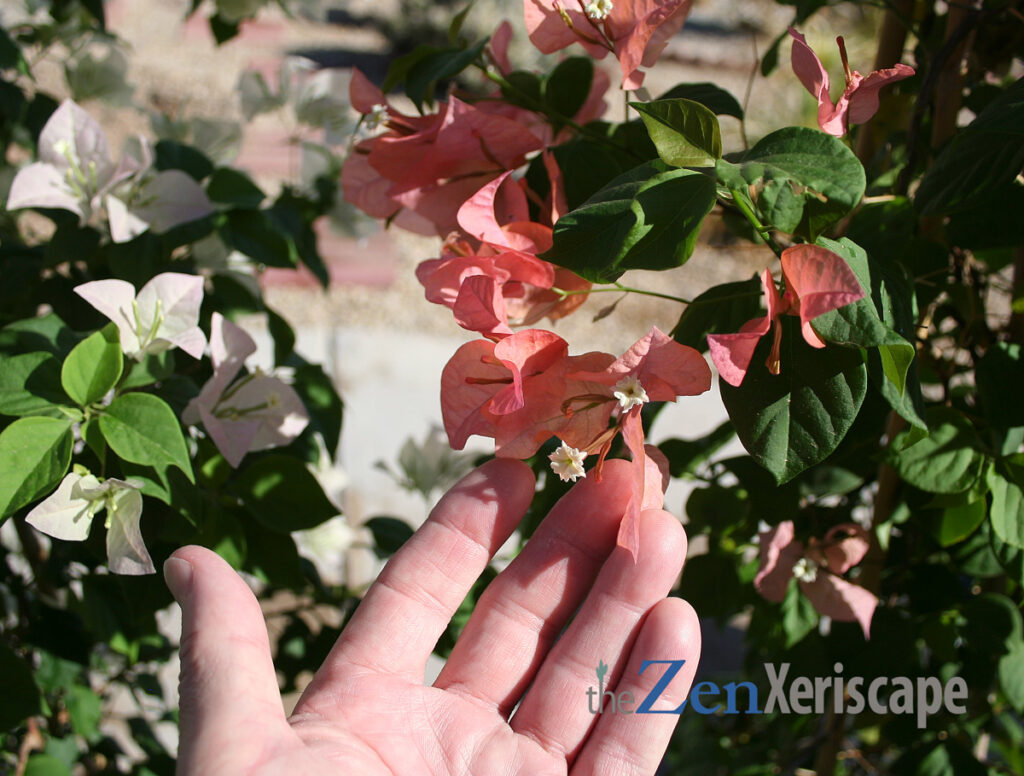
with small white flowers and orange bracts.
Photo by Doug Martin
You might need a trellis for your bougainvillea and rose plants! Browse the wide variety of lovely trellises available on Amazon. (As an Amazon Associate, I earn a commission from qualifying purchases.)
Adapts to different soils:
These plants can thrive in a wide variety of soils. Here in southern Arizona, I mixed some organic garden soil in with our naturally occuring caliche soil to help with water drainage.
Above all, the bougainvillea’s roots should not sit in ponding water. The soil must drain well. Otherwise, this plant’s roots will rot, just like other drought-tolerant plants.
Versatile uses:
POTS AND CONTAINERS: This plant can be grown in containers or pots. The trailing vines can be allowed to hang, or can be trained to grow along a wall, fence, or trellis.
GROUND COVER, BUSH, OR TREE FORM: In addition, bougainvillea can be planted in the soil where it can be trained into a bush form, or its vines can be trained to grow on trellises or walls, or even fences.
In my case, I hope to train my Imperial Thai Delight bougainvillea to grow its branches along a front wall. Eventually, the the colorful bracts will cover the vines with vibrant hues. They will frame and complement a red bird of paradise in the back, as well as contrasting wonderfully with a Mediterranean fan palm, also in the background.
As far as my California Gold and the other orange varieties, I hope to train them into a small tree. That’s going to take some time and some diligent work, but the splendid, striking results will be worthwhile.
Low maintenance:
Once established, all bougainvillea varieities are usually low-maintenance. It is drought-tolerant, so will thrive with minimal water (once established).
It also doesn’t require much fertilizer. However, for best results, use a well-rounded 10-10-10 fertilizer in the spring.
Pruning will be necessary, especially to stimulate more flower (and colorful bract) production. In my neighborhood, most homeowners have their landscapers periodically prune it into a bush-form. However, I have seen one pruned into a tree, with a thick central trunk, and a colorful vegetative crown—it is beautiful, but does require a little more maintenance.
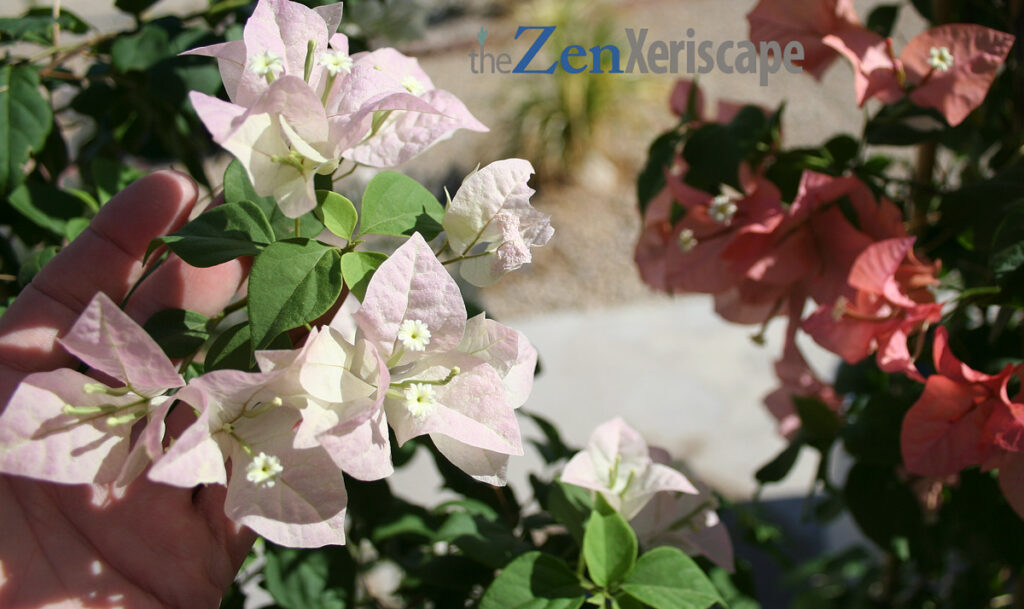
with small white flowers surrounded by
white, pink and purple bracts.
Photo by Doug Martin
There are even trellises for your indoor climbing plants. Browse the wide variety of indoor trellises on Amazon! (As an Amazon Associate, I earn a commission from qualifying purchases.)
Bougainvillea pros and cons
CONS:
Not tolerant of cold weather:
Since bougainvillea is a tropical plant, it is not tolerant of freezing temperatures. It can be perennial if grown in USDA hardiness zones of 9-to-11. Temperatures below the mid-20s F might require protection for your bougainvillea. However, temps that low might kill the vegetation, but it will quickly regrow when warmer, sunnier weather returns.
In colder growing zones, you can use pots or other containers, and bring them in during the colder months. Or, simply grow your bougainvillea as a beautiful annual plant.
Thorns:
Bougainvilleas have sharp thorns that emerge above each leaf, at the leaf axil. They can get long and very woody, and can easily pierce human or animal flesh.
Place in areas away from foot traffic, or in places where children or animals might play. When pruning, wear gloves for protection.
Requires at least six hours of full sun:
For the best flower production and healthy growth, bougainvillea plants require at least six hours of full sun. That full-sun requirement limits where they can be grown.
On the other hand, their love of sun is a positive attribute—they can tolerate full summer sun even in southwestern arid climates.
Susceptible to rabbit and other animal predation:
Despite the thorns, I have discovered that rabbits love to chew on bougainvillea vegetation, as well as its woody stems. I suspect that deer and other hungry creatures might also nibble on and possibly destroy a newly planted bougainvillea.
To deter damage from rabbits, I had to place wire fencing around my Imperial Thai Delight bougainvillea. I’ll keep this fencing in place for a year or more so the plant can get established and grow thicker branches.
Bougainvillea can grow quickly:
This tropical plant can be an aggressive grower under ideal conditions. The vines can easily grow over and smother neighboring plants, so pruning will be necessary.
In addition, pruning is required to stimulate flower production, and to train this plant into a specific shape.
Watering schedules can be tricky to manage:
When first planted, the bougainvillea should be watered regularly, sometimes every day until it grows a healthy system of roots. Once established, watering should be limited to stimulate flower production.
However, the plant should receive enough water to prevent wilting leaves. That watering balance can be tricky, and does require some initial attention.
Browse the large variety of unique indoor plants available on Amazon! (As an Amazon Associate, I earn a commission from qualifying purchases.)
TAKEAWAYS:
Bougainvillea pros and cons
Bougainvillea plants are drought-tolerant, and they love our southwestern heat! They are perfect plants for a drought-tolerant landscape, rock garden, or any garden xeriscape.
They are hardy, easy-to-grow, and produce brilliantly rich, vibrant, tropical color almost year-round. Because of their vigorous growth, they do require regular pruning, but that is a small price to pay.
So far, I am really enjoying my bougainvillea plants in my xeriscape—maybe you should give this plant a place in your landscape, too! If you do, read our article, How to care for bougainvillea!
Content and photos by Doug Martin and The Zen Xeriscape

Buy edible and aromatic herbs to plant indoors or outdoors from Amazon! (As an Amazon Associate, I earn a commission from qualifying purchases.)

